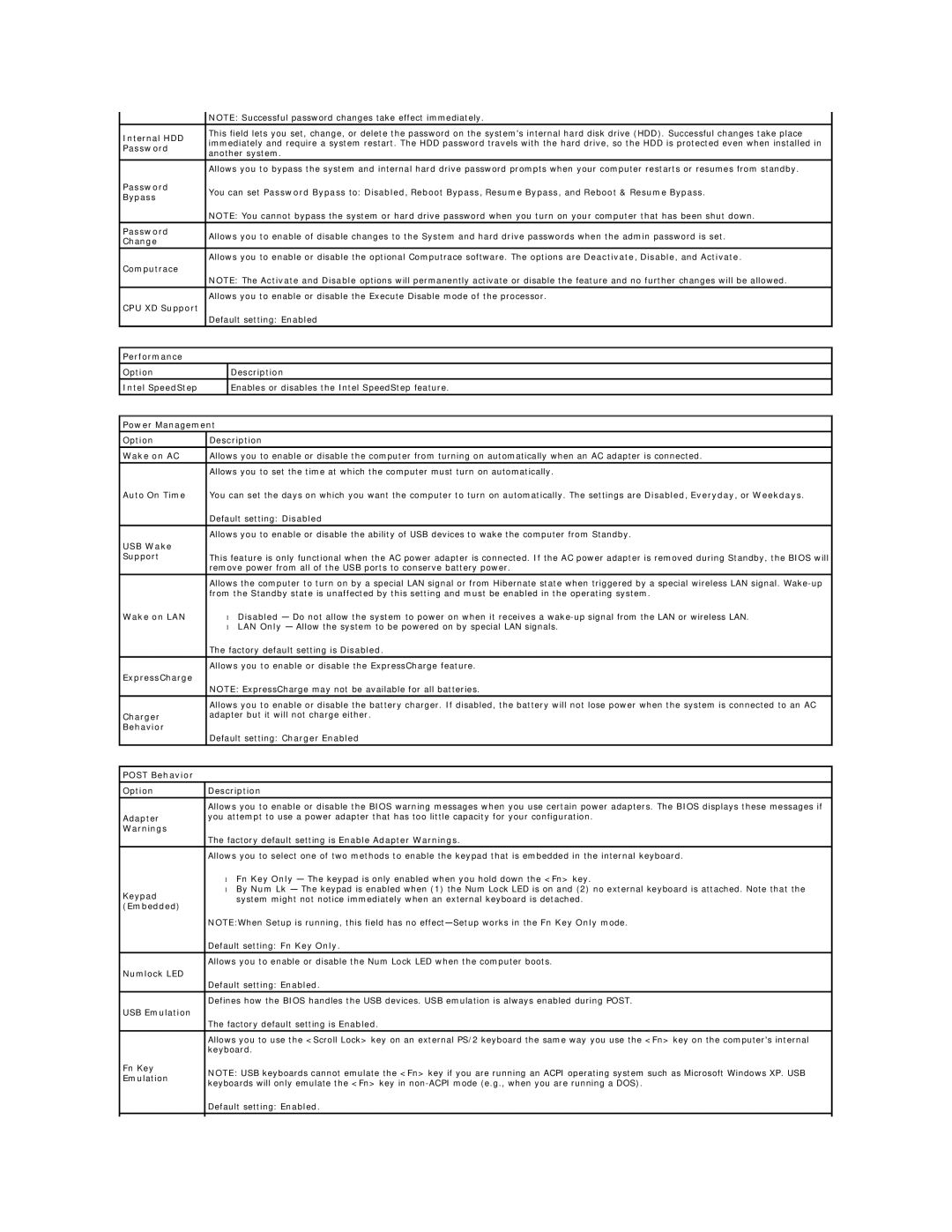
| NOTE: Successful password changes take effect immediately. | |
Internal HDD | This field lets you set, change, or delete the password on the system's internal hard disk drive (HDD). Successful changes take place | |
immediately and require a system restart. The HDD password travels with the hard drive, so the HDD is protected even when installed in | ||
Password | ||
another system. | ||
| ||
| Allows you to bypass the system and internal hard drive password prompts when your computer restarts or resumes from standby. | |
Password | You can set Password Bypass to: Disabled, Reboot Bypass, Resume Bypass, and Reboot & Resume Bypass. | |
Bypass | ||
| ||
| NOTE: You cannot bypass the system or hard drive password when you turn on your computer that has been shut down. | |
Password | Allows you to enable of disable changes to the System and hard drive passwords when the admin password is set. | |
Change | ||
| ||
| Allows you to enable or disable the optional Computrace software. The options are Deactivate, Disable, and Activate. | |
Computrace |
| |
| NOTE: The Activate and Disable options will permanently activate or disable the feature and no further changes will be allowed. | |
| Allows you to enable or disable the Execute Disable mode of the processor. | |
CPU XD Support |
| |
| Default setting: Enabled | |
|
| |
Performance |
|
Option | Description | |
Intel SpeedStep | Enables or disables the Intel SpeedStep feature. | |
|
|
|
Power Management |
| |
Option | Description | |
Wake on AC | Allows you to enable or disable the computer from turning on automatically when an AC adapter is connected. | |
| Allows you to set the time at which the computer must turn on automatically. | |
Auto On Time | You can set the days on which you want the computer to turn on automatically. The settings are Disabled, Everyday, or Weekdays. | |
| Default setting: Disabled | |
| Allows you to enable or disable the ability of USB devices to wake the computer from Standby. | |
USB Wake |
|
|
Support | This feature is only functional when the AC power adapter is connected. If the AC power adapter is removed during Standby, the BIOS will | |
| remove power from all of the USB ports to conserve battery power. | |
| Allows the computer to turn on by a special LAN signal or from Hibernate state when triggered by a special wireless LAN signal. | |
| from the Standby state is unaffected by this setting and must be enabled in the operating system. | |
Wake on LAN | • | Disabled — Do not allow the system to power on when it receives a |
| • | LAN Only — Allow the system to be powered on by special LAN signals. |
| The factory default setting is Disabled. | |
| Allows you to enable or disable the ExpressCharge feature. | |
ExpressCharge |
|
|
| NOTE: ExpressCharge may not be available for all batteries. | |
| Allows you to enable or disable the battery charger. If disabled, the battery will not lose power when the system is connected to an AC | |
Charger | adapter but it will not charge either. | |
Behavior |
|
|
| Default setting: Charger Enabled | |
|
|
|
POST Behavior |
|
|
Option | Description | |
| Allows you to enable or disable the BIOS warning messages when you use certain power adapters. The BIOS displays these messages if | |
Adapter | you attempt to use a power adapter that has too little capacity for your configuration. | |
Warnings |
|
|
| The factory default setting is Enable Adapter Warnings. | |
| Allows you to select one of two methods to enable the keypad that is embedded in the internal keyboard. | |
•Fn Key Only — The keypad is only enabled when you hold down the <Fn> key.
•By Num Lk — The keypad is enabled when (1) the Num Lock LED is on and (2) no external keyboard is attached. Note that the
Keypad | system might not notice immediately when an external keyboard is detached. | |
(Embedded) | ||
| ||
| NOTE:When Setup is running, this field has no | |
| Default setting: Fn Key Only. | |
| Allows you to enable or disable the Num Lock LED when the computer boots. | |
Numlock LED |
| |
| Default setting: Enabled. | |
| Defines how the BIOS handles the USB devices. USB emulation is always enabled during POST. | |
USB Emulation |
| |
| The factory default setting is Enabled. | |
| Allows you to use the <Scroll Lock> key on an external PS/2 keyboard the same way you use the <Fn> key on the computer's internal | |
| keyboard. | |
Fn Key | NOTE: USB keyboards cannot emulate the <Fn> key if you are running an ACPI operating system such as Microsoft Windows XP. USB | |
Emulation | ||
keyboards will only emulate the <Fn> key in | ||
| ||
| Default setting: Enabled. |
